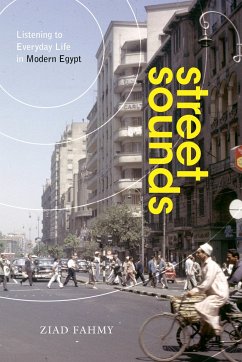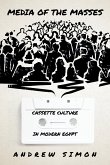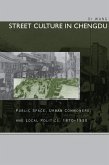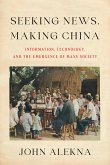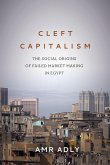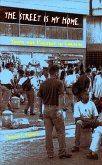- Gebundenes Buch
- Merkliste
- Auf die Merkliste
- Bewerten Bewerten
- Teilen
- Produkt teilen
- Produkterinnerung
- Produkterinnerung
As the twentieth century roared on, transformative technologies-from trains, trams, and automobiles to radios and loudspeakers-fundamentally changed the sounds of the Egyptian streets. The cacophony of everyday life grew louder, and the Egyptian press featured editorials calling for the regulation of not only mechanized and amplified sounds, but also the voices of street vendors, the music of wedding processions, and even the traditional funerary wails. Ziad Fahmy offers the first historical examination of the changing soundscapes of urban Egypt, highlighting the mundane sounds of street life,…mehr
Andere Kunden interessierten sich auch für
![Media of the Masses Media of the Masses]() Andrew SimonMedia of the Masses144,99 €
Andrew SimonMedia of the Masses144,99 €![The Language of the English Street Sign The Language of the English Street Sign]() Vivian CookThe Language of the English Street Sign165,99 €
Vivian CookThe Language of the English Street Sign165,99 €![Street Culture in Chengdu Street Culture in Chengdu]() Di WangStreet Culture in Chengdu132,99 €
Di WangStreet Culture in Chengdu132,99 €![Seeking News, Making China Seeking News, Making China]() John AleknaSeeking News, Making China163,99 €
John AleknaSeeking News, Making China163,99 €![Cleft Capitalism Cleft Capitalism]() Amr AdlyCleft Capitalism152,99 €
Amr AdlyCleft Capitalism152,99 €![Back Stories Back Stories]() Amahl A BisharaBack Stories140,99 €
Amahl A BisharaBack Stories140,99 €![The Street Is My Home The Street Is My Home]() Patricia C MárquezThe Street Is My Home165,99 €
Patricia C MárquezThe Street Is My Home165,99 €-
-
-
As the twentieth century roared on, transformative technologies-from trains, trams, and automobiles to radios and loudspeakers-fundamentally changed the sounds of the Egyptian streets. The cacophony of everyday life grew louder, and the Egyptian press featured editorials calling for the regulation of not only mechanized and amplified sounds, but also the voices of street vendors, the music of wedding processions, and even the traditional funerary wails. Ziad Fahmy offers the first historical examination of the changing soundscapes of urban Egypt, highlighting the mundane sounds of street life, while "listening" to the voices of ordinary people as they struggle with state authorities for ownership of the streets. Interweaving infrastructural, cultural, and social history, Fahmy analyzes the sounds of modernity, using sounded sources as an analytical tool for examining the past. Street Sounds also reveals a political dimension of noise by demonstrating how the growing middle classes used sound to distinguish themselves from the Egyptian masses. This book contextualizes sound, layering historical analysis with a sensory dimension, bringing us closer to the Egyptian streets as lived and embodied by everyday people.
Hinweis: Dieser Artikel kann nur an eine deutsche Lieferadresse ausgeliefert werden.
Hinweis: Dieser Artikel kann nur an eine deutsche Lieferadresse ausgeliefert werden.
Produktdetails
- Produktdetails
- Verlag: Stanford University Press
- Seitenzahl: 312
- Erscheinungstermin: 25. August 2020
- Englisch
- Abmessung: 231mm x 150mm x 25mm
- Gewicht: 612g
- ISBN-13: 9781503612013
- ISBN-10: 1503612015
- Artikelnr.: 57168729
- Herstellerkennzeichnung
- Libri GmbH
- Europaallee 1
- 36244 Bad Hersfeld
- 06621 890
- Verlag: Stanford University Press
- Seitenzahl: 312
- Erscheinungstermin: 25. August 2020
- Englisch
- Abmessung: 231mm x 150mm x 25mm
- Gewicht: 612g
- ISBN-13: 9781503612013
- ISBN-10: 1503612015
- Artikelnr.: 57168729
- Herstellerkennzeichnung
- Libri GmbH
- Europaallee 1
- 36244 Bad Hersfeld
- 06621 890
Ziad Fahmy is Associate Professor of Modern Middle East History at Cornell University. He is the author of Ordinary Egyptians: Creating the Modern National through Popular Culture (Stanford, 2011).
Contents and Abstracts
Introduction: Introduction: Historicizing Sounds and Soundscapes
chapter abstract
In the Introduction I briefly examine the importance of the field of sound
studies and the need for historians of the Middle East to engage with the
sounds of the past. I discuss the importance of "listening" to the sources,
in order to mine the archives for sonic events. Finally, Street Sounds
proposes that by taking into account the changing sounds of the past, and
by examining how people dealt with their daily sounded environment, we can
be brought closer to a more embodied microlevel analysis of mundane street
life. This is especially true in a period of rapid sonic transition, which
exemplified the infrastructural and technological transformations during
the first half of the twentieth century.
1Walking the City: Street Voices, Traffic, and the Mundane Sounds of
Everyday Life
chapter abstract
Inspired in part by Michel de Certeau's The Practice of Everyday Life, in
Chapter 1, I describe life in early- to mid-twentieth-century Cairo from a
pedestrian's perspective. "Walking the City: Street Voices, Traffic, and
the Mundane Sounds of Everyday Life" is devoted to the sounds of
pedestrians and commuters as I analyze the ways that they used, occupied,
and walked through those public spaces to commute, work, sell, and shop,
and to entertain and be entertained. The first part of the chapter examines
some of the social implications of embodied noises, from jingling anklets
and bracelets to footsteps, as ordinary Cairenes were negotiating their way
through a rapidly changing city. The second half of the chapter focuses on
the calls of street hawkers, entertainers, and merchants who relied on
their voices to advertise their goods and services.
2Silencing the Streets: Classism, Fear of the Crowd, and Regulating Sounds
and Bodies
chapter abstract
Chapter 2, "Silencing the Streets: Classism, Fear of the Crowd, and
Regulating Sounds and Bodies," examines both the Egyptian government's
attempts at regulating and silencing public spaces and the class
implications of these policies. New anti-begging and anti-homelessness
discourses invoked fears of an imminent breakdown of public order and even
public health. In this chapter, I also document the interrelated and
ever-present class bias in the Egyptian press, especially with regard to
its coverage of the urban streets, street hawkers, and the itinerant poor.
3Roads and Tracks: Modern Traffic and the Sensory and Social Impact of
Trams and Automobiles
chapter abstract
Chapter 3, "Roads and Tracks: Modern Traffic and the Sensory and Social
Impact of Trams and Automobiles," examines the modernization of Egypt's
urban infrastructure, especially roads and tramways. The changing sounds
and the social impact of growing urban traffic is carefully examined, with
an emphasis on the introduction of tramways and motor vehicles. The chapter
also documents and elaborates on the sonic impact of new urban spaces from
large city squares to bustling transportation hubs. The problems of
dramatically increased motor traffic and early attempts at regulating car
horn noise are especially investigated.
4The Soundscapes of Modernity: Electricity, Lights and the Sounds of
Nightlife
chapter abstract
Chapter 4, "The Soundscapes of Modernity: Electricity, Lights and the
Sounds of Nightlife," begins by examining the professional lighting of
Egyptian cities by private gas utilities and the introduction of
electricity and electric lighting. The sonic implication of electricity was
of course enormous as it not only allowed the eventual proliferation of
radios, loudspeakers, and tramways, but just as importantly brought the
electric lights that forever changed the sounds of the Egyptian night. The
growth of a regularly boisterous nightlife and the establishment of newer
places of public leisure, from amusement parks to cabarets and movie
theaters catering to diverse audiences, are closely examined.
5The Sounds of Weddings and Funerals: From Brass Bands to Wails and
Ululations
chapter abstract
Chapter 5 examines the evolving street sounds of traditional Egyptian
weddings and funerals, which involved elaborate street processions and a
variety of auditory and visual displays. It examines the changing roles of
street music, singing, loud funerary grieving, and other important verbal
and nonverbal vocalizations. The chapter concludes by examining some of the
attacks directed against many of the embodied and auditory aspects of these
traditional ceremonies by the government and by both secular and Islamic
modernists. The one point all the "modernizing" camps agreed on was their
belief in the general ignorance of the vast majority of the population and
the urgent need for education, reform, and uplift. The chapter also
addresses how many of these vulgarizing discourses played a role in the
class distinction of Egypt's growing middle classes as they
self-consciously attempted to define and separate themselves from the
masses through sensory differentiation.
6Sounding Out State Power: Cannons, Music, and Loudspeakers
chapter abstract
In Chapter 6, "Sounding Out State Power: Cannons, Music and Loudspeakers,"
I examine the Egyptian state's appropriation of large religious and secular
celebrations and festivals. The chapter centers exclusively on the official
sounds and spectacles performed and sponsored by the Egyptian state in an
ongoing effort to legitimize its secular and religious authority in the
eyes and ears of the masses. As I demonstrate in this chapter, drums,
cannons, and twenty-one gun salutes are as important as uniforms, flags,
and propaganda posters. I will particularly focus on the state's use of
music, microphones, and radio speeches broadcast over loudspeakers during
parades, festivals, and other large public gatherings.
Conclusion: Conclusion: Class Distinction and Remembering Lost Sounds
chapter abstract
The Conclusion briefly summaries some of the key arguments of the book and
delves into the interrelationship between memory, class, nationalism, and
the senses. It discusses the contradiction between an apparent nostalgia
for street sounds of the past and a simultaneous vulgarization of
contemporary street sounds.
Introduction: Introduction: Historicizing Sounds and Soundscapes
chapter abstract
In the Introduction I briefly examine the importance of the field of sound
studies and the need for historians of the Middle East to engage with the
sounds of the past. I discuss the importance of "listening" to the sources,
in order to mine the archives for sonic events. Finally, Street Sounds
proposes that by taking into account the changing sounds of the past, and
by examining how people dealt with their daily sounded environment, we can
be brought closer to a more embodied microlevel analysis of mundane street
life. This is especially true in a period of rapid sonic transition, which
exemplified the infrastructural and technological transformations during
the first half of the twentieth century.
1Walking the City: Street Voices, Traffic, and the Mundane Sounds of
Everyday Life
chapter abstract
Inspired in part by Michel de Certeau's The Practice of Everyday Life, in
Chapter 1, I describe life in early- to mid-twentieth-century Cairo from a
pedestrian's perspective. "Walking the City: Street Voices, Traffic, and
the Mundane Sounds of Everyday Life" is devoted to the sounds of
pedestrians and commuters as I analyze the ways that they used, occupied,
and walked through those public spaces to commute, work, sell, and shop,
and to entertain and be entertained. The first part of the chapter examines
some of the social implications of embodied noises, from jingling anklets
and bracelets to footsteps, as ordinary Cairenes were negotiating their way
through a rapidly changing city. The second half of the chapter focuses on
the calls of street hawkers, entertainers, and merchants who relied on
their voices to advertise their goods and services.
2Silencing the Streets: Classism, Fear of the Crowd, and Regulating Sounds
and Bodies
chapter abstract
Chapter 2, "Silencing the Streets: Classism, Fear of the Crowd, and
Regulating Sounds and Bodies," examines both the Egyptian government's
attempts at regulating and silencing public spaces and the class
implications of these policies. New anti-begging and anti-homelessness
discourses invoked fears of an imminent breakdown of public order and even
public health. In this chapter, I also document the interrelated and
ever-present class bias in the Egyptian press, especially with regard to
its coverage of the urban streets, street hawkers, and the itinerant poor.
3Roads and Tracks: Modern Traffic and the Sensory and Social Impact of
Trams and Automobiles
chapter abstract
Chapter 3, "Roads and Tracks: Modern Traffic and the Sensory and Social
Impact of Trams and Automobiles," examines the modernization of Egypt's
urban infrastructure, especially roads and tramways. The changing sounds
and the social impact of growing urban traffic is carefully examined, with
an emphasis on the introduction of tramways and motor vehicles. The chapter
also documents and elaborates on the sonic impact of new urban spaces from
large city squares to bustling transportation hubs. The problems of
dramatically increased motor traffic and early attempts at regulating car
horn noise are especially investigated.
4The Soundscapes of Modernity: Electricity, Lights and the Sounds of
Nightlife
chapter abstract
Chapter 4, "The Soundscapes of Modernity: Electricity, Lights and the
Sounds of Nightlife," begins by examining the professional lighting of
Egyptian cities by private gas utilities and the introduction of
electricity and electric lighting. The sonic implication of electricity was
of course enormous as it not only allowed the eventual proliferation of
radios, loudspeakers, and tramways, but just as importantly brought the
electric lights that forever changed the sounds of the Egyptian night. The
growth of a regularly boisterous nightlife and the establishment of newer
places of public leisure, from amusement parks to cabarets and movie
theaters catering to diverse audiences, are closely examined.
5The Sounds of Weddings and Funerals: From Brass Bands to Wails and
Ululations
chapter abstract
Chapter 5 examines the evolving street sounds of traditional Egyptian
weddings and funerals, which involved elaborate street processions and a
variety of auditory and visual displays. It examines the changing roles of
street music, singing, loud funerary grieving, and other important verbal
and nonverbal vocalizations. The chapter concludes by examining some of the
attacks directed against many of the embodied and auditory aspects of these
traditional ceremonies by the government and by both secular and Islamic
modernists. The one point all the "modernizing" camps agreed on was their
belief in the general ignorance of the vast majority of the population and
the urgent need for education, reform, and uplift. The chapter also
addresses how many of these vulgarizing discourses played a role in the
class distinction of Egypt's growing middle classes as they
self-consciously attempted to define and separate themselves from the
masses through sensory differentiation.
6Sounding Out State Power: Cannons, Music, and Loudspeakers
chapter abstract
In Chapter 6, "Sounding Out State Power: Cannons, Music and Loudspeakers,"
I examine the Egyptian state's appropriation of large religious and secular
celebrations and festivals. The chapter centers exclusively on the official
sounds and spectacles performed and sponsored by the Egyptian state in an
ongoing effort to legitimize its secular and religious authority in the
eyes and ears of the masses. As I demonstrate in this chapter, drums,
cannons, and twenty-one gun salutes are as important as uniforms, flags,
and propaganda posters. I will particularly focus on the state's use of
music, microphones, and radio speeches broadcast over loudspeakers during
parades, festivals, and other large public gatherings.
Conclusion: Conclusion: Class Distinction and Remembering Lost Sounds
chapter abstract
The Conclusion briefly summaries some of the key arguments of the book and
delves into the interrelationship between memory, class, nationalism, and
the senses. It discusses the contradiction between an apparent nostalgia
for street sounds of the past and a simultaneous vulgarization of
contemporary street sounds.
Contents and Abstracts
Introduction: Introduction: Historicizing Sounds and Soundscapes
chapter abstract
In the Introduction I briefly examine the importance of the field of sound
studies and the need for historians of the Middle East to engage with the
sounds of the past. I discuss the importance of "listening" to the sources,
in order to mine the archives for sonic events. Finally, Street Sounds
proposes that by taking into account the changing sounds of the past, and
by examining how people dealt with their daily sounded environment, we can
be brought closer to a more embodied microlevel analysis of mundane street
life. This is especially true in a period of rapid sonic transition, which
exemplified the infrastructural and technological transformations during
the first half of the twentieth century.
1Walking the City: Street Voices, Traffic, and the Mundane Sounds of
Everyday Life
chapter abstract
Inspired in part by Michel de Certeau's The Practice of Everyday Life, in
Chapter 1, I describe life in early- to mid-twentieth-century Cairo from a
pedestrian's perspective. "Walking the City: Street Voices, Traffic, and
the Mundane Sounds of Everyday Life" is devoted to the sounds of
pedestrians and commuters as I analyze the ways that they used, occupied,
and walked through those public spaces to commute, work, sell, and shop,
and to entertain and be entertained. The first part of the chapter examines
some of the social implications of embodied noises, from jingling anklets
and bracelets to footsteps, as ordinary Cairenes were negotiating their way
through a rapidly changing city. The second half of the chapter focuses on
the calls of street hawkers, entertainers, and merchants who relied on
their voices to advertise their goods and services.
2Silencing the Streets: Classism, Fear of the Crowd, and Regulating Sounds
and Bodies
chapter abstract
Chapter 2, "Silencing the Streets: Classism, Fear of the Crowd, and
Regulating Sounds and Bodies," examines both the Egyptian government's
attempts at regulating and silencing public spaces and the class
implications of these policies. New anti-begging and anti-homelessness
discourses invoked fears of an imminent breakdown of public order and even
public health. In this chapter, I also document the interrelated and
ever-present class bias in the Egyptian press, especially with regard to
its coverage of the urban streets, street hawkers, and the itinerant poor.
3Roads and Tracks: Modern Traffic and the Sensory and Social Impact of
Trams and Automobiles
chapter abstract
Chapter 3, "Roads and Tracks: Modern Traffic and the Sensory and Social
Impact of Trams and Automobiles," examines the modernization of Egypt's
urban infrastructure, especially roads and tramways. The changing sounds
and the social impact of growing urban traffic is carefully examined, with
an emphasis on the introduction of tramways and motor vehicles. The chapter
also documents and elaborates on the sonic impact of new urban spaces from
large city squares to bustling transportation hubs. The problems of
dramatically increased motor traffic and early attempts at regulating car
horn noise are especially investigated.
4The Soundscapes of Modernity: Electricity, Lights and the Sounds of
Nightlife
chapter abstract
Chapter 4, "The Soundscapes of Modernity: Electricity, Lights and the
Sounds of Nightlife," begins by examining the professional lighting of
Egyptian cities by private gas utilities and the introduction of
electricity and electric lighting. The sonic implication of electricity was
of course enormous as it not only allowed the eventual proliferation of
radios, loudspeakers, and tramways, but just as importantly brought the
electric lights that forever changed the sounds of the Egyptian night. The
growth of a regularly boisterous nightlife and the establishment of newer
places of public leisure, from amusement parks to cabarets and movie
theaters catering to diverse audiences, are closely examined.
5The Sounds of Weddings and Funerals: From Brass Bands to Wails and
Ululations
chapter abstract
Chapter 5 examines the evolving street sounds of traditional Egyptian
weddings and funerals, which involved elaborate street processions and a
variety of auditory and visual displays. It examines the changing roles of
street music, singing, loud funerary grieving, and other important verbal
and nonverbal vocalizations. The chapter concludes by examining some of the
attacks directed against many of the embodied and auditory aspects of these
traditional ceremonies by the government and by both secular and Islamic
modernists. The one point all the "modernizing" camps agreed on was their
belief in the general ignorance of the vast majority of the population and
the urgent need for education, reform, and uplift. The chapter also
addresses how many of these vulgarizing discourses played a role in the
class distinction of Egypt's growing middle classes as they
self-consciously attempted to define and separate themselves from the
masses through sensory differentiation.
6Sounding Out State Power: Cannons, Music, and Loudspeakers
chapter abstract
In Chapter 6, "Sounding Out State Power: Cannons, Music and Loudspeakers,"
I examine the Egyptian state's appropriation of large religious and secular
celebrations and festivals. The chapter centers exclusively on the official
sounds and spectacles performed and sponsored by the Egyptian state in an
ongoing effort to legitimize its secular and religious authority in the
eyes and ears of the masses. As I demonstrate in this chapter, drums,
cannons, and twenty-one gun salutes are as important as uniforms, flags,
and propaganda posters. I will particularly focus on the state's use of
music, microphones, and radio speeches broadcast over loudspeakers during
parades, festivals, and other large public gatherings.
Conclusion: Conclusion: Class Distinction and Remembering Lost Sounds
chapter abstract
The Conclusion briefly summaries some of the key arguments of the book and
delves into the interrelationship between memory, class, nationalism, and
the senses. It discusses the contradiction between an apparent nostalgia
for street sounds of the past and a simultaneous vulgarization of
contemporary street sounds.
Introduction: Introduction: Historicizing Sounds and Soundscapes
chapter abstract
In the Introduction I briefly examine the importance of the field of sound
studies and the need for historians of the Middle East to engage with the
sounds of the past. I discuss the importance of "listening" to the sources,
in order to mine the archives for sonic events. Finally, Street Sounds
proposes that by taking into account the changing sounds of the past, and
by examining how people dealt with their daily sounded environment, we can
be brought closer to a more embodied microlevel analysis of mundane street
life. This is especially true in a period of rapid sonic transition, which
exemplified the infrastructural and technological transformations during
the first half of the twentieth century.
1Walking the City: Street Voices, Traffic, and the Mundane Sounds of
Everyday Life
chapter abstract
Inspired in part by Michel de Certeau's The Practice of Everyday Life, in
Chapter 1, I describe life in early- to mid-twentieth-century Cairo from a
pedestrian's perspective. "Walking the City: Street Voices, Traffic, and
the Mundane Sounds of Everyday Life" is devoted to the sounds of
pedestrians and commuters as I analyze the ways that they used, occupied,
and walked through those public spaces to commute, work, sell, and shop,
and to entertain and be entertained. The first part of the chapter examines
some of the social implications of embodied noises, from jingling anklets
and bracelets to footsteps, as ordinary Cairenes were negotiating their way
through a rapidly changing city. The second half of the chapter focuses on
the calls of street hawkers, entertainers, and merchants who relied on
their voices to advertise their goods and services.
2Silencing the Streets: Classism, Fear of the Crowd, and Regulating Sounds
and Bodies
chapter abstract
Chapter 2, "Silencing the Streets: Classism, Fear of the Crowd, and
Regulating Sounds and Bodies," examines both the Egyptian government's
attempts at regulating and silencing public spaces and the class
implications of these policies. New anti-begging and anti-homelessness
discourses invoked fears of an imminent breakdown of public order and even
public health. In this chapter, I also document the interrelated and
ever-present class bias in the Egyptian press, especially with regard to
its coverage of the urban streets, street hawkers, and the itinerant poor.
3Roads and Tracks: Modern Traffic and the Sensory and Social Impact of
Trams and Automobiles
chapter abstract
Chapter 3, "Roads and Tracks: Modern Traffic and the Sensory and Social
Impact of Trams and Automobiles," examines the modernization of Egypt's
urban infrastructure, especially roads and tramways. The changing sounds
and the social impact of growing urban traffic is carefully examined, with
an emphasis on the introduction of tramways and motor vehicles. The chapter
also documents and elaborates on the sonic impact of new urban spaces from
large city squares to bustling transportation hubs. The problems of
dramatically increased motor traffic and early attempts at regulating car
horn noise are especially investigated.
4The Soundscapes of Modernity: Electricity, Lights and the Sounds of
Nightlife
chapter abstract
Chapter 4, "The Soundscapes of Modernity: Electricity, Lights and the
Sounds of Nightlife," begins by examining the professional lighting of
Egyptian cities by private gas utilities and the introduction of
electricity and electric lighting. The sonic implication of electricity was
of course enormous as it not only allowed the eventual proliferation of
radios, loudspeakers, and tramways, but just as importantly brought the
electric lights that forever changed the sounds of the Egyptian night. The
growth of a regularly boisterous nightlife and the establishment of newer
places of public leisure, from amusement parks to cabarets and movie
theaters catering to diverse audiences, are closely examined.
5The Sounds of Weddings and Funerals: From Brass Bands to Wails and
Ululations
chapter abstract
Chapter 5 examines the evolving street sounds of traditional Egyptian
weddings and funerals, which involved elaborate street processions and a
variety of auditory and visual displays. It examines the changing roles of
street music, singing, loud funerary grieving, and other important verbal
and nonverbal vocalizations. The chapter concludes by examining some of the
attacks directed against many of the embodied and auditory aspects of these
traditional ceremonies by the government and by both secular and Islamic
modernists. The one point all the "modernizing" camps agreed on was their
belief in the general ignorance of the vast majority of the population and
the urgent need for education, reform, and uplift. The chapter also
addresses how many of these vulgarizing discourses played a role in the
class distinction of Egypt's growing middle classes as they
self-consciously attempted to define and separate themselves from the
masses through sensory differentiation.
6Sounding Out State Power: Cannons, Music, and Loudspeakers
chapter abstract
In Chapter 6, "Sounding Out State Power: Cannons, Music and Loudspeakers,"
I examine the Egyptian state's appropriation of large religious and secular
celebrations and festivals. The chapter centers exclusively on the official
sounds and spectacles performed and sponsored by the Egyptian state in an
ongoing effort to legitimize its secular and religious authority in the
eyes and ears of the masses. As I demonstrate in this chapter, drums,
cannons, and twenty-one gun salutes are as important as uniforms, flags,
and propaganda posters. I will particularly focus on the state's use of
music, microphones, and radio speeches broadcast over loudspeakers during
parades, festivals, and other large public gatherings.
Conclusion: Conclusion: Class Distinction and Remembering Lost Sounds
chapter abstract
The Conclusion briefly summaries some of the key arguments of the book and
delves into the interrelationship between memory, class, nationalism, and
the senses. It discusses the contradiction between an apparent nostalgia
for street sounds of the past and a simultaneous vulgarization of
contemporary street sounds.

